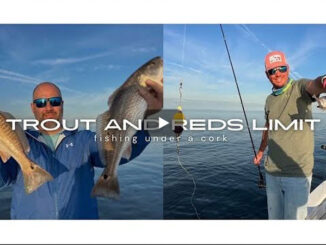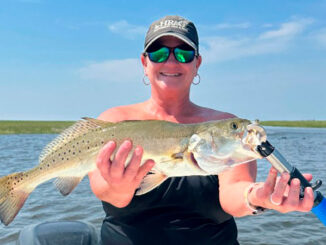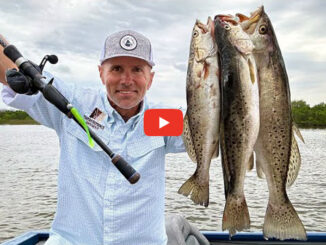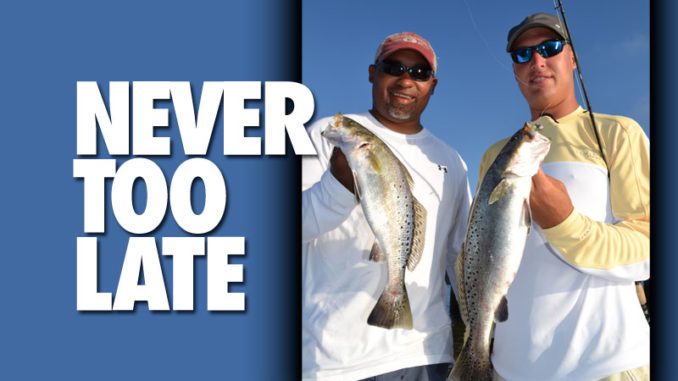
If you think the trophy trout train has already passed by, think again. Here are two places to target and several techniques to use.
Among anglers who target trophy speckled trout, August gets less respect than Rodney Dangerfield in a room full of ADD kids. Poll 100 big-fish chasers about their favorite month, and 80 will say May. The other 20 will flip the calendar to April, June or even February.
But August isn’t likely to be anyone’s top choice. It is sometimes torturous to fish in the eighth month. We’d complain about the heat if we could only breathe the stifling air. Besides that, speckled trout begin to scatter in August, with younger fish making the trek toward inside waters that will support them in the fall and the big brutes abandoning the seasonal spawn and becoming loners.
The dreaded transition will likely begin sometime this month, but the good news for anglers is there are still some monsters to be had, particularly in the first half of august. Just ask Tony Bruce. In 2015, the fisherman from Zachary landed a 6.8-pound speckled trout that won him a boat in the STAR tournament.
When was that fish caught? Aug. 7.
Big boys in Breton
An incredibly successful tournament and rodeo angler in his own right, Kris Robert makes his living guiding out of Slidell, and that means most years, his favorite trophy trout hotspot is awfully close to home.
“If I’ve got some clients, and they’re fishing a rodeo, and they’re like, ‘Look, we’re not worried about numbers; we just want size,’ my first thought is, with the spillway not opened, I’d probably say, ‘We’re going to go to L&N and catch the tide right. We’re just going to fish those deep holes (20 feet or more), where the water’s flowing,’” Robert said. “In a normal year, those fish are starting to jam up in there, trying to make that transition in August and September.”
But this year is less normal than a January hurricane, so Robert’s Plan B is Breton Sound.
“I’m going to find deep water and flowing water,” he said. “Those are the two most-important elements in August.”
They’re available all over Breton Sound, and many around visible oil-field structures. Robert will hit those occasionally, especially early in the week, but on weekends, he’s fishing only stuff that doesn’t breach the surface of the water.
“You want to fish something that’s hard to find,” he said. “Those big trout are big for a reason. They’re not going to hang around where people are chucking anchors and pounding on them consistently. They’re going somewhere else, where there’s the least amount of boat traffic or fishing pressure they can find.”
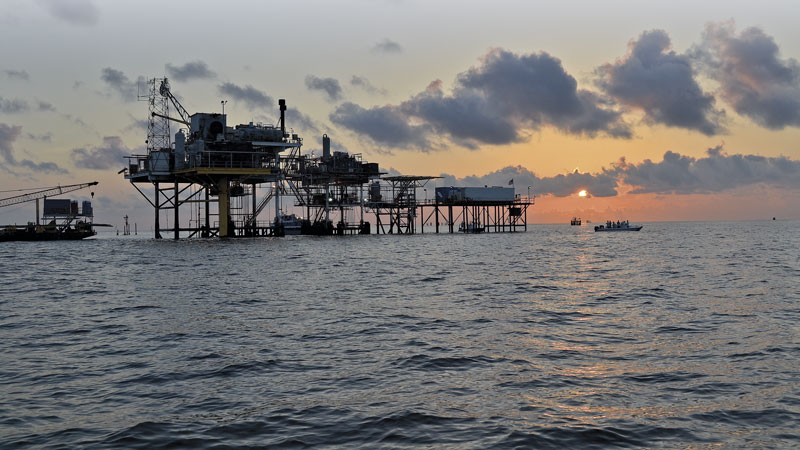
Locating that type of place requires lots of hours staring at a depth finder or making friends with other trophy trout anglers.
“You hang around with enough people or do enough research, you hear about boats that got sunk, offshore wrecks or shell piles,” Robert said. “That’s the type of stuff you want to fish. You always hear people talk about the Dope Boat or the Pogie Boat. A lot of people don’t know where they’re at, so they don’t get as much pressure as the stuff that’s visible.
“We went the other day to the Pogie Boat, and it’s probably about 18 feet of water there. So it’s deep, there’s water flowing from the Gulf into the Sound and vice versa, and obviously there’s structure. That’s where those big fish congregate.”
Make sure your timing is right
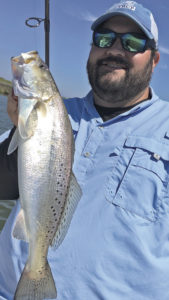
But simply finding an area that’s likely to hold trophy trout isn’t enough. As with many things in life, timing is everything, Robert said.
“If you want exclusively big fish, they’re only going to bite right at daylight and right before sunset,” he said. “The only time during the day you’ve got a good chance for big trout is during the swapping tide. You get the tide swapping or start slowing down, that first 30 minutes or so, they’ll feed again.
“They’re no different than us. When it’s hot, you don’t really feel like stuffing your face. You just want to get where it’s cool and relax. They’re the same way. They’ll just lay up all day.”
But when they ARE feeding, they’re actually pretty easy to catch, Robert said.
“In August, the fish are spawned out, so they’re looking to eat,” he said. “They’re just crushing everything that comes through there.”
Robert will offer live croakers or live jumbo shrimp — 10- to 16-count — and he likes them rigged a particular way.
“When I’m fishing big trout — and this does make a difference — a Carolina rig is the best way to go because the bait is free-flowing in the current,” he said. “Those big trout have been around a while and have seen a lot of things. If a bait is kind of constricted, it doesn’t look natural. So I like a Carolina rig with a long leader so that bait can just do what it does.”
Robert will use a 1/2- to 1-ounce egg sinker, depending on the current, and a long, 20-pound fluorocarbon leader. He also likes a surprisingly small hook, a No. 8 treble.
“I want a hook you can hide,” he said. “I want that fish to be able to suck that bait up and get it down in its throat. I’d rather them swallow that bait so I know they’re not getting off as opposed to using a Kahle hook and hoping he gets hooked in the side of the mouth or somewhere.
“If I’m fishing a rodeo, I’m going to keep the fish anyway, so I’m not worried about him swallowing it.”
Cocodrie conundrum
When it comes to trophy-trout production, this south-central Louisiana port lives in the shadows of giants to the east and west — Calcasieu Lake and Venice. But the big-fish production there is actually underrated, according to Chris Macaluso, director of the center for marine fisheries for the Theodore Roosevelt Conservation Partnership.
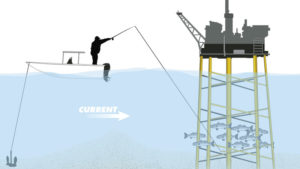
Every summer, Macaluso fishes rodeos out of both Cocodrie and Grand Isle, and he’s figured out that certain places south of the former hold numbers of fish, while others feature just a few lunkers.
“There are some rigs out in front of Last Island that stretch all the way from in front of Wine Island all the way to Raccoon,” he said. “They’re in 20 to 30 feet of water. That’s where I always look first when the conditions are right.
“There are a couple in particular right out in front of Last Island that are only two or three miles in front of the island. They always hold some big fish, but that time of year, they’re also going to be loaded up with bull redfish and other things that are going to beat you up, but they’re really good places to look.”
Before he hits those platforms searching for trophies, though, Macaluso invests hours in his prep time.
“The trouble in Cocodrie is not necessarily finding fish that can win you a rodeo; the trouble is finding the right bait,” he said. “You don’t necessarily need live bait to go try, but it wouldn’t hurt. And finding good-sized croakers or mullet is kind of up to you. You’re probably not going to be able to buy the size bait you need.”
Macaluso loves a livewell full of big croaker and mullet, but he also totes along a tackle box stuffed to the gills with baits no school trout angler would ever consider using.
“I throw big swimbaits and soft-plastics, like 7-inch Gulp Jerk Shads, big Zoom bass baits or H&H Queen Cocahoes,” he said. “You need that bigger profile for those big fish. You might catch one on a small bait, but your chances go way up with those bigger baits.”
Exactly how Macaluso presents those baits depends on the conditions he finds, but he tries just about everything before abandoning a platform.
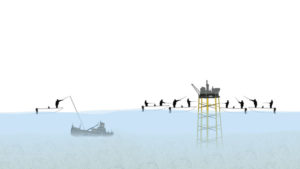
“Sometimes they’re suspended,” he said. “Generally, what we’ll do is just poke around and fish different corners of the rig — fish the downcurrent side, fish the upcurrent side. Sometimes it’s better to anchor upcurrent and fish the bait down into the rig; sometimes the fish will be on a particular corner, depending on the tide. You can rig-hook and try to fish them that way. It just depends on the day.
“I would say your most-consistent action is going to be anchoring upcurrent and drifting the baits back down into the rig, but I’ve also caught a lot of nice fish tying to the downcurrent side and throwing the bait up into the rig with a big, heavy jighead.”
Macaluso said August doesn’t scare him at all. He actually kind of likes the month, with the exception of one popular area.
“I’ve caught nice trout in late summer all over Cocodrie,” he said. “I’ll tell you where I wouldn’t go, though, is Lake Pelto. They’re just not in there that time of year. The water’s shallow, and it’s been hit hard pretty much all spring and summer.”
